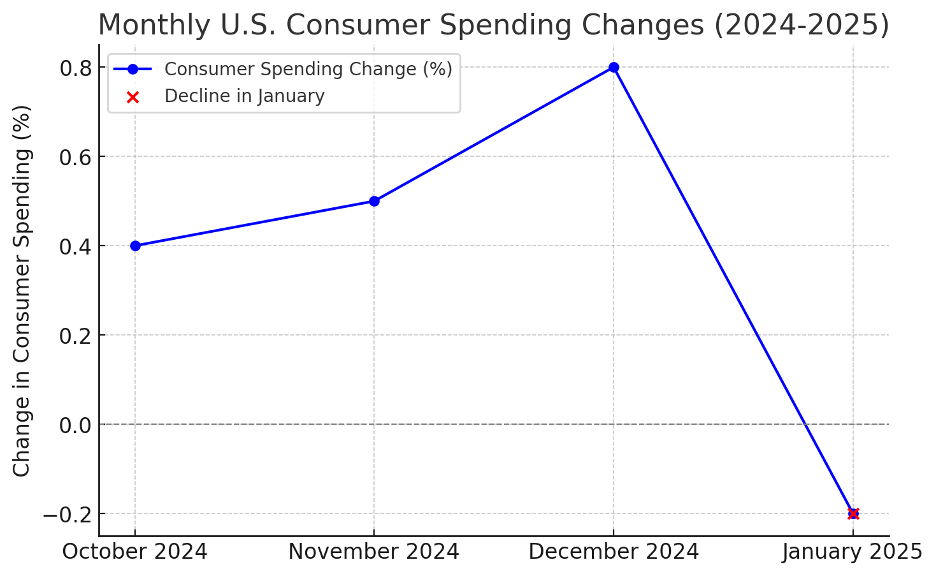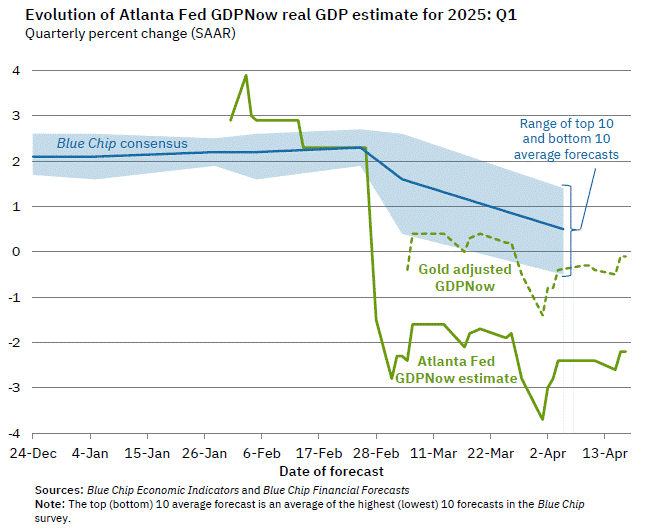Consumer spending in the US suffered its first drop in nearly two years, falling 300% shy of expectations. The decline is even more severe when accounting for inflation. This zapping of consumer spending appetite reflects broader economic weakness, including stubborn inflation, jittery consumer confidence, and policy uncertainty. This web of challenges puts the Federal Reserve in a sticky spot, potentially forcing a swift shift in monetary policy. All these warning signals have led to a 5% drop in official Q1 GDP projections.
Consumer Spending Crashes
In January, consumer spending contracted by 0.2%, marking the first downward trend since March 2023. Data from the Bureau of Economic Analysis revealed this unexpected dip following almost two years of uninterrupted positive activity. Americans maintained steady spending throughout Q4 2024, with expenditures doubling from October to December before the January fallout.

A Reuters survey of economists expected a 0.1% increase in spending—lower than late 2024 but still positive. Instead, the 0.2% reduction marked a 300% shortfall from projections. When factoring in inflation, spending shrank by 0.5%, the largest loss since February 2021. Inflation reflects the true value of consumer activity, offering a more accurate view of buying habits.
Consumer Confidence Beat Down
As economic activity weathered a considerable downturn, consumer confidence also plunged, recording its biggest monthly drop since August 2021. The Conference Board’s Consumer Confidence Index®–the economy’s unofficial benchmark for consumer outlook–fell by 7.0 points.
According to the group’s Senior Economist, Stephanie Guichard, “This is the third consecutive month on month decline, bringing the Index to the bottom of the range that has prevailed since 2022.” Public sentiment on the economy worsened across key areas, including business conditions, the labor market, and income prospects, ultimately increasing recession fears.
GDP Expectations Fall by Nearly 7%
A mix of sticky inflation, weaker consumer spending and confidence, policy uncertainty, and broader economic concerns has sharply lowered Q1 2025 GDP expectations. The Atlanta Fed’s GDPNow metric recorded a nearly 7% drop from late January to early March. Projected GDP growth fell from around 4% to 2.8% in weeks, highlighting significant economic volatility and widespread instability.

https://www.atlantafed.org/cqer/research/gdpnow
Tariffs Remain the Wildcard
Amidst widespread economic uncertainty, Trump’s tariff policy is a wildcard. The administration has acknowledged the possibility of “short-term pain, long-term gain” as the country secures more favorable trade agreements. However, the whiplashing on tariff policies is keeping the economy on edge. Businesses are hesitant to hire, consumers are cutting back on spending, and investors are weary of traditional assets.
“Tariffs are the most obvious threat to the pricing environment and the last few tenths to the Fed’s 2% target remain in the crosshairs,” highlights Shannon Grein, an economist at Wells Fargo.
Recently, Trump declined to rule out declined to rule out a recession in 2025 when pressed on the impact of his disruptive economic policies.
The Federal Reserve Conundrum
The Federal Reserve suspended rate cuts to assess how Trump’s bold agenda would impact the economy. Now, the country’s fiscal leaders are caught between stubborn inflation and stagnant growth—equally concerning issues that demand opposing solutions. Cutting rates too quickly could exacerbate inflation, and keeping rates elevated may spur an economic contraction. This lose-lose scenario highlights the precarious state of the economy and reflects the uncertainty investors face.


